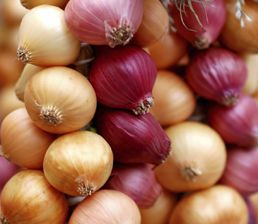 Onions Australia represents the biosecurity interests of onion producers and the industry. They are members of Plant Health Australia and signatories to the Emergency Plant Pest Response Deed. Their responsibilities include:
Onions Australia represents the biosecurity interests of onion producers and the industry. They are members of Plant Health Australia and signatories to the Emergency Plant Pest Response Deed. Their responsibilities include:
- biosecurity planning and implementation at the national and farm levels
- liaising with federal and state governments on trade issues
- funding and supporting biosecurity initiatives
- participating in national committees and response efforts in an emergency.
Industry overview
Onions are grown in most states, but South Australia and Tasmania together produce 66 per cent of the Australian crop. Key onion production locations are the Lockyer Valley in Queensland, north-eastern regions and the Adelaide Plains of South Australia and the Devonport–Launceston region of Tasmania. The total area planted to onions is largest in South Australia, as is the average plantings per farm.
The main type of onion grown in Australia is the traditional brown onion, which accounts for 79 per cent of fresh production. Onion production is during late spring, summer and autumn. Planting starts around April through to September, harvesting from August to March, and storage supplies the market for the winter months.
Biosecurity plans, manuals and resources
Expand
 Biosecurity Plan for the Onion Industry
Biosecurity Plan for the Onion Industry
Biosecurity planning provides a mechanism for the onion industry, government and other relevant stakeholders to assess current biosecurity practices and future biosecurity needs. Planning identifies procedures that can be put in place to reduce the chance of pests reaching our borders or minimise the impact if a pest incursion occurs.
The Biosecurity Plan for the Onion Industry outlines key threats to the industry, risk mitigation plans, identification and categorisation of exotic pests and contingency plans. For a copy, please contact PHA on 02 6215 7700 or email biosecurity@phau.com.au.
 Onions Growers' Biosecurity Manual
Onions Growers' Biosecurity Manual
The Onion Growers' Biosecurity Manual contains information to help growers to implement biosecurity on-farm. Manuals usually contain an overview of biosecurity, fact sheets to identify the high priority pests of a crop, tips on crop management, and how to manage people, vehicles and equipment to minimise biosecurity risks. Manuals also contain a biosecurity self-assessment list, and templates to record pest surveillance records and visitors.
More information about on-farm biosecurity for both plant and livestock producers is available from the Farm Biosecurity website.
Pollination information
Expand
Pests
Expand
Exotic pests (not in Australia)
The following is a list of high priority exotic pests of onions. These pests were identified during the development of the Industry Biosecurity Plan for the Onion Industry in consultation with industry, government and scientists. They have been assessed as high priority pests based on their potential to enter, establish, and spread in Australia (eg environmental factors, host range, vectors) and the cost to industry of control measures.
PHA has a range of fact sheets, contingency plans and diagnostic protocols relevant to these pests. Pest risk review documents are also available for some pests. Please contact PHA on 02 6215 7700 or email biosecurity@phau.com.au for more information.
Endorsed National Diagnostic Protocols are available from the National Plant Biosecurity Diagnostic Network webpage.
Other pests
The following is a list of documents for other exotic and endemic pests of the onion industry. Please note that this is not a complete list of pests: rather it includes pests for which documents exist in the Pest Information Document Database.
Some of the documents presented here are not tailored to the onion industry and are included for information only.
 Onions Australia represents the biosecurity interests of onion producers and the industry. They are members of Plant Health Australia and signatories to the Emergency Plant Pest Response Deed. Their responsibilities include:
Onions Australia represents the biosecurity interests of onion producers and the industry. They are members of Plant Health Australia and signatories to the Emergency Plant Pest Response Deed. Their responsibilities include:
 Biosecurity Plan for the Onion Industry
Biosecurity Plan for the Onion Industry




Recent Comments